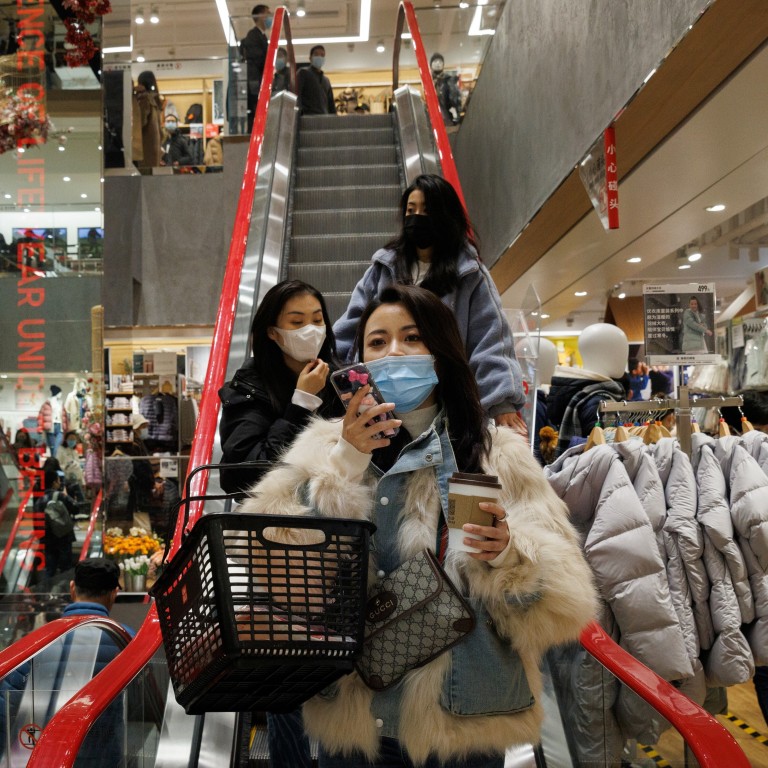
China’s consumption growth surprises analysts, and outlook for exports and property market remains uncertain
- China’s economy had staged an impressive recovery from the impact of the coronavirus until numerous headwinds began taking their toll on economic growth
- NBS official tells the Post that official database was recently updated with more historical data ‘to promote openness and transparency of statistics’
China’s economy showed signs of stabilising in October as retail sales and industrial production bounced back from the previous month and beat expectations, but officials and experts are warning of a bleak outlook in the recovery due to pandemic uncertainties and global supply-chain issues.
Sporadic outbreaks of Covid-19 have dampened economic momentum, said Sheana Yue, an assistant economist with Capital Economics. As the outbreaks continue, movements will continue to be limited, and consumption growth will remain slow. However, “any near-term virus-linked disruptions should prove temporary”, Yue added.
“However, it should also be noted that there are still many factors of international instability and uncertainty,” NBS spokesman Fu Linghui said. “There are still constraints on the recovery of the domestic economy, and the upwards cost pressure on enterprises is increasing.”
Data before October 1996 had been unavailable until the update pushed the available records back to January 1993. Given the update, the PPI reading for October was a 26-year high – the highest since July 1995, rather than an all-time high.
The NBS official, who spoke on condition of anonymity, also said: “The change is to promote openness and transparency of statistics,” while noting that the PPI statistic was first compiled in 1993.
“The general trend is like that, as long as the data can be made public, we will add as much as possible,” she said, suggesting that the practice was likely to extend to other indicators.
The NBS also said that retail sales – a key gauge of consumer spending in the world’s most populous nation – grew by 4.9 per cent in October compared with a year earlier, up from the 4.4 per cent increase in September and beating analysts’ expectations in a Bloomberg survey.
And industrial production, a gauge of activity in the manufacturing, mining and utilities sectors, grew by 3.5 per cent in October from a year earlier, after a 3.1 per cent gain in September.
Meanwhile, growth of fixed-asset investment – a gauge of expenditure on items including infrastructure, property, machinery and equipment – remained weak. It rose by 6.1 per cent in the January-October period, compared with a year earlier, and was down from a rise of 7.3 per cent in the first three quarters.
NBS data also showed that property investment and sales growth remained sluggish over the January-October period, and Yue at Capital Economics expects the property downturn to deepen further as developers continue to cut back on new projects in response to weaker demand and growing financial strains.
Zhang Zhiwei, chief economist at Pinpoint Asset Management, expects the central government to unveil measures to beef up investment.
“We think macro policies are close to a turning point,” Zhang said. “We expect the government to boost fiscal spending around the year’s end to stabilise the weakening trend in investment.”
At Monday’s press conference, Fu also noted that the imported impact of rising international commodity prices, along with the tight supply of some domestic energy and raw material products, have led to a higher increase in PPI.
“It seems to show some signs of stagflation, but on the whole, this should be a transitory situation caused by some short-term impact factors,” Fu said.
The surveyed jobless rate, an imperfect measurement of unemployment in China, stood at 4.9 per cent in October, unchanged from September, the NBS data showed.
China set a target of creating 11 million new urban jobs and a surveyed urban unemployment rate of 5.5 per cent for this year. According to the data, China created 11.33 million jobs in the first 10 months of the year.


